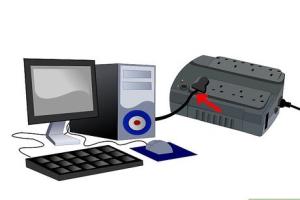Ultimate Guide to Buying and Using an Uninterruptible Power Supply (UPS)

-
Quick Links:
- What is an Uninterruptible Power Supply (UPS)?
- Importance of Using a UPS
- Types of UPS Systems
- How to Buy the Right UPS
- Setting Up Your UPS
- How to Use Your UPS Effectively
- Maintenance Tips for Your UPS
- Troubleshooting Common UPS Issues
- Case Studies: UPS in Action
- FAQs
What is an Uninterruptible Power Supply (UPS)?
An Uninterruptible Power Supply (UPS) is a device that provides backup power to connected devices when the primary power source fails. Unlike a regular power supply, a UPS can instantly switch to battery power, ensuring that your devices remain operational during outages, surges, or fluctuations in power quality.
Importance of Using a UPS
The importance of having a UPS cannot be overstated. Here are some key reasons:
- Data Protection: A UPS helps protect your data from corruption due to sudden power loss.
- Equipment Longevity: By providing a stable power supply, a UPS can prolong the life of sensitive electronics.
- Productivity: Ensures that your work is not interrupted during power outages, enhancing productivity.
- Safety: Prevents electrical hazards that may occur due to sudden power cuts.
Types of UPS Systems
There are primarily three types of UPS systems:
- Offline/Standby UPS: The most basic type, which switches to battery power when a power failure is detected.
- Line-Interactive UPS: Offers better protection against voltage fluctuations by correcting minor issues without switching to battery power.
- Online UPS: Provides the highest level of protection by continuously running on battery power, which is then recharged by the unit.
How to Buy the Right UPS
When selecting a UPS, consider the following factors:
- Power Requirements: Calculate the total wattage of the devices you want to protect.
- Battery Runtime: Determine how long you need the UPS to keep your devices running during an outage.
- Features: Look for features like LCD displays, USB connectivity, and automatic voltage regulation.
- Brand Reputation: Research brands that are known for reliability and customer service.
For example, if you are running a home office with a desktop computer, monitor, and router, you might need a UPS that provides at least 800VA to ensure you have enough power for a short outage.
Setting Up Your UPS
Follow these steps to set up your UPS:
- Choose a Location: Place the UPS in a well-ventilated area away from direct sunlight and moisture.
- Connect Your Devices: Plug your devices into the battery-backed outlets of the UPS.
- Connect to Power: Plug the UPS into a wall outlet.
- Turn It On: Power on the UPS and check for any warning lights or error messages.
How to Use Your UPS Effectively
To maximize the utility of your UPS:
- Regularly check the battery status and replace it when necessary.
- Understand the load capacity and avoid overloading the UPS.
- Utilize any software that comes with the UPS for monitoring and management.
Maintenance Tips for Your UPS
To ensure your UPS operates effectively:
- Perform regular self-tests to check battery health.
- Keep the UPS clean and dust-free.
- Replace batteries according to manufacturer recommendations.
Troubleshooting Common UPS Issues
Here are some common issues and how to troubleshoot them:
- UPS Doesn't Power On: Check the power connection and ensure the outlet is functional.
- Batteries Drain Quickly: Test the battery health and consider replacing it if necessary.
- Output Voltage Fluctuations: Ensure the UPS is not overloaded and check for any environmental issues.
Case Studies: UPS in Action
1. Small Business: A local small business utilized a UPS during a power outage and successfully avoided data loss and downtime, improving their recovery strategy.
2. Home Office: A freelancer reported that their UPS saved critical work during a sudden outage, allowing them to submit a project on time.
FAQs
- 1. What is the average lifespan of a UPS?
- The typical lifespan of a UPS battery is between 3 to 5 years, depending on usage and maintenance.
- 2. Can I connect a UPS to a surge protector?
- No, it is not recommended to connect a UPS to a surge protector as it can interfere with its operation.
- 3. How do I know what size UPS I need?
- Calculate the total wattage of all devices you want to connect and choose a UPS that exceeds this value.
- 4. Is it safe to use a UPS with sensitive electronics?
- Yes, a UPS provides clean power and protects sensitive electronics from surges and spikes.
- 5. Can I replace the battery in my UPS?
- Yes, most UPS units have replaceable batteries. Check the user manual for instructions.
- 6. How often should I test my UPS?
- It's advisable to perform a self-test monthly to check the battery health and functionality.
- 7. What happens if the UPS battery is completely drained?
- If the battery is drained, the UPS will no longer provide backup power until it is recharged.
- 8. Can I use a UPS with a generator?
- Yes, but you should ensure that the generator's output is stable and compatible with the UPS specifications.
- 9. What features should I look for in a UPS?
- Look for features such as LCD displays, surge protection, battery status indicators, and USB connectivity.
- 10. How do I dispose of an old UPS?
- Follow local regulations for electronic waste disposal, and consider recycling the battery properly.
Random Reads
- How to find amazon influencer storefronts
- How to safely kill creepers in minecraft
- How to install opitfine mod
- How to install macos virtualbox
- How to seal around basin bathtub silicone
- How to solve parallel circuits
- How to turn on playstation 4
- How to turn on wireless charging on iphone
- How to copy formulas in excel
- How to replace a recessed bulb